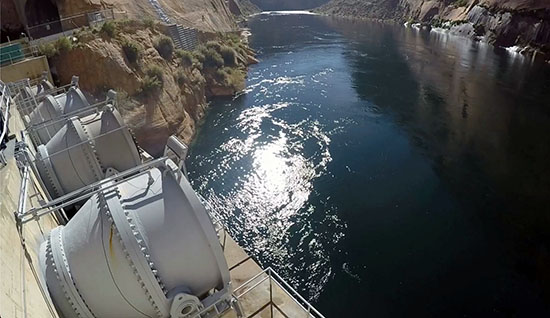
Discussion:
Talk about this article...

Dam safety concerns at Glen Canyon Dam
April 09, 2024
by John S. Weisheit

The four river outlet tubes at Glen Canyon Dam. NPS photo.

PROPOSAL TO RE-ENGINEER BYPASS FEATURES AT GLEN CANYON DAM
REPAIRS OFFICIALLY BEGIN FOR RIVER OUTLET WORKS
OPERATION OF RIVER OUTLET WORKS ARE CURRENTLY UNSAFE
News of April 2024
Other News
General Design Specifications
- The design of the river outlets was based on concrete having a compressive strength of 3,000 pounds per square inch at 28 days for structural concrete and 2,500 pounds per square inch at 28 days for mass concrete.
- The river outlets provide for releases for downstream commitments when the powerplant is not in operation and during the period of final closure of the diversion tunnels. The outlets will also be used to maximum capacity during maximum flood releases.
- There are a total of four tubes. Each tube has a total of seven bends: three vertical bends, three horizontal bends and one contour bend. The bends are where cavitation (vapor implosions) problems are more significant.
MEMOS AND REPORTS
Federal Agencies
DESIGN SPECIFICATIONS OF GLEN CANYON DAM
SUMMARY OF THE DATA
Penstock tubes to the turbines
- The centerline elevation of the penstock tubes is 3,470 feet
- The minimal reservoir elevation for the safe operation of the turbines is 3,520 feet; 50 feet above the centerline of the penstocks.
- The fish in the reservoir can be sucked into the penstocks and the turbines.
Tubes to the River Outlet Works
- The centerline of the river outlet tubes is 3,374 feet
- The aquatic life of the reservoir can be sucked through the river outlet works.
- The river outlet works can perform normally until the reservoir elevation reaches 3,467 feet; 93 feet above the centerline at the entrance of the river tubes. Thereafter, the velocity of the flow is incrementally reduced, until....
- At reservoir elevation 3,420 feet, it is not safe to operate the river tubes at all. At that point....
- The only flow in the riverbed behind the dam would be the natural leakage/seepage that flows around the dam, or through bed gravels of the river.
- Since 2002, the leakage/seepage flow rate averages about 208 cubic feet per second.
- That flow rate would be greatly diminished with a reservoir that has exhausted its water storage.
- The remobilization of exposed reservoir sediment would probably dictate closing the river outlet tubes sooner. The sediment would include decomposing organics and hydrogen sulfide, which are extremely odorous and toxic.
MOVIE
REPAIR PROPOSAL 2022
River Outlet Works Pipe Relining at Glen Canyon Power Plant
- Document: Solicitation 140R4023R0010 Glen Canyon Dam River Outlet Works Pipe Relining
- The Bureau of Reclamation, Upper Colorado Basin, is seeking potential sources to reline the river outlet works pipe at the Glen Canyon Power Plant.
- The Contractor shall provide all the expertise, labor, tools and equipment necessary to reline 4 river outlet tubes at Glen Canyon Power Plant.
- Work is located at Glen Canyon Dam, approximately 2 miles northwest of Page, Arizona, in Coconino County.
Work Details
- Control ponding, seeping, and flowing leakage water in outlet works during relining operations.
- Outlet pipe (4 total) Abrasive blast clean surfaces to remove corrosion and existing linings, create a surface profile, and apply a new lining system on interior surfaces of outlet works pipe from bell mouth transition to hollow jet valve. Including manhole covers interior and exterior surfaces. Approximately 22,600 square feet of surface preparation and lining.
- To include Interior Drain Line 140 square feet and Exterior Coating of Drain line 20 square feet.
- High pressure water jet clean to remove corrosion and existing lining and apply new surface tolerant lining for drain lines on outlet works pipes.
- Furnish and install cathodic protection if any corrosion is observed in the bell mouth of an outlet works pipe.
- Contain, handle, and dispose of hazardous coating materials.
- Allowable window for work is approximately April through October.
- The contract specialist and point of contact for this request for information is Jennifer Handy. Please submit responses and any other inquiries via email to jhandy@usbr.gov.
####
THE LITTLE FLOOD OF 1983
Spillways at Glen Canyon Dam (see the specifications as written in 1961)
- Original volume for a probable maximum snowmelt, from April to July (four to five months), is forecasted to be 29,600,000 acre-feet, and the river flow rate would peak at 380,000 cfs.
- A probable maximum rain event, which is predicted to occur in the fall (hurricane season), would have a peak discharge of 417,000 cfs and a 6-day volume of 2,063,600 acre-feet.
- These proposed engineering specifications are pointless because in a real-time event that occurred 23 years after this spec sheet was written, the spillways at Glen Canyon Dam failed during the snowmelt of 1983 after only one week of emergency operations and at 20 percent of nameplate capacity.
- The four month snow melt was only 15,000,000 acre-feet; peak flow into Lake Powell was only 104,000 cfs.
- The spillway repairs following the snowmelt of 1983 included air injection mechanisms to minimize the cavitation pressures. This modification diminished the total capacity of the spillway discharge by 25 percent.
- Therefore, even if the spillways could avoid failure during a four to five month snowmelt, such a surge of melt water would of course overtop the dam and destroy the powerplant below and erode the foundation bedrock around the dam.
- Will such a scenario unfold? Paleoflood hydrologists have evidence of four snow melts in the last 2,000 years greater than 380,000 acre-feet.
- If it happened in the past, it will happen in the future.
- REFERENCE: Lessons Learned: Case Study at Glen Canyon Dam Arizona, 1983. ASDSO.
Quantitative Paleoflood Hydrology
ADDITIONAL READING
Science and History

Discussion:
Talk about this article...
|
 |
 |
 |


